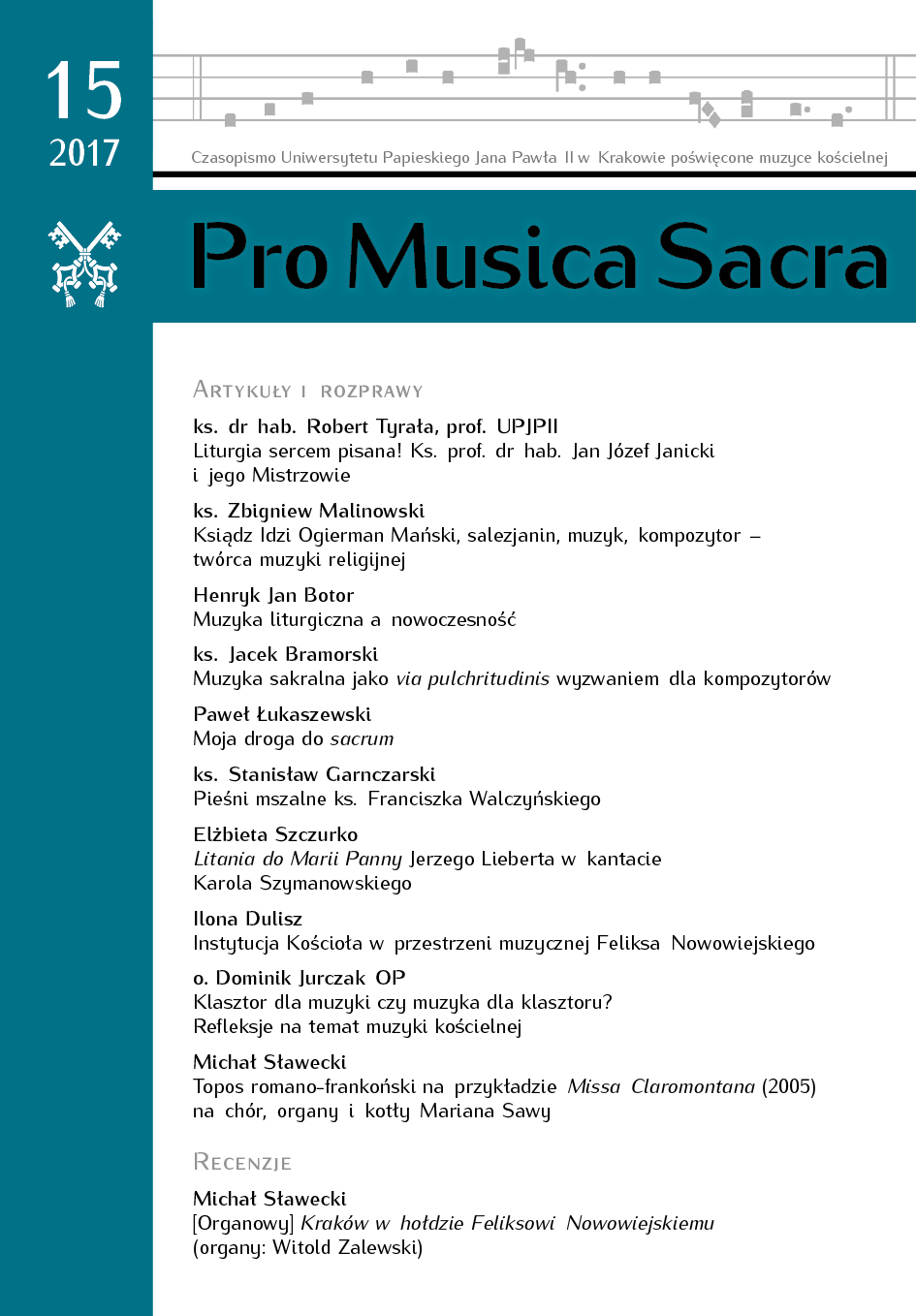My way to the sacrum
DOI:
https://doi.org/10.15633/pms.2254Keywords:
liturgy, religious music, Requiem, Resurrectio, sacrum, symbols, The Catholic church, time, Vesperae pro defunctis, Via crucis, importanceAbstract
It is my profound conviction that it is better to write music which is “my own” than the one which is just “new”. I have therefore distanced myself from the musical avant‑garde and I have discovered sacred music as my creative path. It includes over a dozen large‑scale vocal‑instrumental works, such as Vesperae pro defunctis, Requiem, Via crucis, Resurrectio, Missa de Maria a Magdala, Magnificat & Nunc dimittis, Miserere, four Symphonies – of Providence, of Love, of Angels and on the Mercy of God, as well as a wide range of a cappella choral compositions. Works exploring the theme of transience (Vesperae pro defunctis, Requiem) and those linked to the spirituality of the Passion and Easter (Via crucis, Resurrectio) constitute other important strands in my output. In order to describe my musical idiom I have coined the term “renewed tonality”, which seems to me to fit the sound material that I employ in my pieces.
The article cites the documents of the Catholic Church relating to music, including the texts by Popes Pius X and Pius XII, and the Constitution of the Sacred Liturgy of the Second Vatican Council. In writing sacred music I am trying to follow the Catholic Church’s voice expressed in these documents, for I believe that sacred music should be holy and universal. I also follow the musicologist Bohdan Pociej in invoking the four ways in which composers enter the sphere of the sacrum: religious theme, religious climate, sacred time and sound, and sacred form, all of which find their reflection in my music.
References
Burakowski D., Znaczenie traktatów Boecjusza dla rekonstrukcji nauki pitagorejskiej w epoce wczesnochrześcijańskiej, „IDEA – Studia nad strukturą i rozwojem pojęć filozoficznych” 19 (2007), s. 5–11.
Constitutio pastoralis de Ecclesia in mundo huius temporis Gaudium et Spes, w: Sobór Watykański II, Konstytucje, dekrety, deklaracje, Poznań 1965.
Einstein A., Leksykon złotych myśli, wybór K. Nowak, Warszawa 1998.
Nadolski B., Liturgika, t. 3, Poznań 1992.
Pikulik J., Dokumenty Stolicy Apostolskiej o muzyce XX wieku, w: Muzyka religijna w Polsce, t. 10, red. J. Pikulik, Warszawa 1988.
Pociej B., Czy możliwy jest w muzyce mistycyzm, w: Muzyka religijna w Polsce, t. 10, red. J. Pikulik, Warszawa 1988.
Sobór Watykański II, Konstytucje, dekrety, deklaracje, Poznań 1968.
Albert Einstein, Wikicytaty, [online] https://pl.wikiquote.org/wiki/Albert_Einstein (13.03.2017).
Downloads
Published
Issue
Section
License
Authors who publish with this journal agree to the following terms:
- Authors retain the copyright and full publishing rights without restrictions, and grant the journal right of first publication with the work simultaneously licensed under a Creative Commons Attribution 4.0 International License that allows others to share the work with an acknowledgement of the work's authorship and initial publication in this journal.
- Authors are able to enter into separate, additional contractual arrangements for the non-exclusive distribution of the journal's published version of the work (e.g., post it to an institutional repository or publish it in a book), with an acknowledgement of its initial publication in this journal.
- Authors are permitted and encouraged to post their work online (e.g., in institutional repositories or on their website) prior to and during the submission process, as it can lead to productive exchanges, as well as earlier and greater citation of published work (See The Effect of Open Access).

